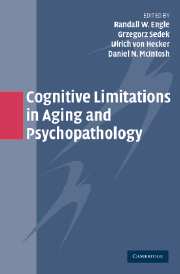Book contents
- Frontmatter
- Contents
- List of Contributors
- Preface
- Acknowledgments
- 1 Cognitive Limitations in Aging and Psychopathology: An Introduction and a Brief Tutorial to Research Methods
- SECTION I WORKING MEMORY AND COGNITIVE FUNCTIONS
- SECTION II AGING AND PSYCHOPATHOLOGY OF COGNITIVE CONTROL
- 5 The Aging of Cognitive Control: Studies of Conflict Processing, Goal Neglect, and Error Monitoring
- 6 Cognitive Control and Schizophrenia: Psychological and Neural Mechanisms
- 7 Aging and Varieties of Cognitive Control: A Review of Meta-Analyses on Resistance to Interference, Coordination, and Task Switching, and an Experimental Exploration of Age-Sensitivity in the Newly Identified Process of Focus Switching
- 8 An Ecological Approach to Studying Aging and Dual-Task Performance
- 9 Cognitive Performance After Preexposure to Uncontrollability and in a Depressive State: Going with a Simpler “Plan B”
- SECTION III ATTENTION, INHIBITION, AND REASONING PROCESSES
- Name Index
- Subject Index
- References
6 - Cognitive Control and Schizophrenia: Psychological and Neural Mechanisms
Published online by Cambridge University Press: 20 May 2010
- Frontmatter
- Contents
- List of Contributors
- Preface
- Acknowledgments
- 1 Cognitive Limitations in Aging and Psychopathology: An Introduction and a Brief Tutorial to Research Methods
- SECTION I WORKING MEMORY AND COGNITIVE FUNCTIONS
- SECTION II AGING AND PSYCHOPATHOLOGY OF COGNITIVE CONTROL
- 5 The Aging of Cognitive Control: Studies of Conflict Processing, Goal Neglect, and Error Monitoring
- 6 Cognitive Control and Schizophrenia: Psychological and Neural Mechanisms
- 7 Aging and Varieties of Cognitive Control: A Review of Meta-Analyses on Resistance to Interference, Coordination, and Task Switching, and an Experimental Exploration of Age-Sensitivity in the Newly Identified Process of Focus Switching
- 8 An Ecological Approach to Studying Aging and Dual-Task Performance
- 9 Cognitive Performance After Preexposure to Uncontrollability and in a Depressive State: Going with a Simpler “Plan B”
- SECTION III ATTENTION, INHIBITION, AND REASONING PROCESSES
- Name Index
- Subject Index
- References
Summary
Schizophrenia is a complex and debilitating psychiatric disorder that affects approximately one percent of the population. Lay conceptions of schizophrenia typically focus on symptoms such as hallucinations, delusions, and disorganized speech, which are often considered the hallmark features of this disorder. However, clinicians, researchers, and theorists have long noted that individuals with schizophrenia also commonly suffer from disturbances in memory and cognition, often severely so. Interestingly, recent research suggests that disturbances in social and occupational functioning in individuals with schizophrenia may be more influenced by the severity of their cognitive deficits than the severity of symptoms such as hallucinations and delusions (Green, Kern, Braff, & Mintz, 2000). Such findings have led to a resurgence of interest in identifying the nature of cognitive abnormalities in schizophrenia. A close examination of the types of symptoms and cognitive disturbances displayed by individuals suggests that many of these disturbances appear to reflect an inability to control or regulate their cognitive and emotional states. In this chapter, we review the evidence that one of the core cognitive disturbances in schizophrenia is a deficit in one or more components of executive function, which leads to disturbances in the ability to appropriately regulate thoughts and behavior in accordance with internal goals. More specifically, we suggest that individuals with schizophrenia suffer from a disturbance in a specific type of executive control process that we refer to as a deficit in the ability to represent and maintain context.
- Type
- Chapter
- Information
- Cognitive Limitations in Aging and Psychopathology , pp. 122 - 159Publisher: Cambridge University PressPrint publication year: 2005
References
- 5
- Cited by



